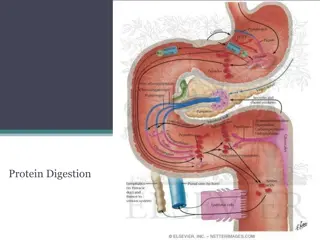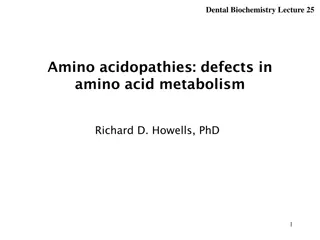Investigating the Role of Amino Acid 381 in BK Channel Clustering
The study explores the significance of amino acid 381 in the function of dystrophin to localize SLO-1 in C. elegans. By utilizing the T381I mutation, the research aims to determine whether a SLO-1 BK channel with this mutation exhibits a clustered or non-clustered phenotype. Proposed methods involve genetic manipulations using CRISPR-Cas9 technology and microscopy to observe the phenotypic changes. This investigation sheds light on the molecular mechanisms underlying ethanol resistance in worms.
Uploaded on Oct 10, 2024 | 3 Views
Download Presentation

Please find below an Image/Link to download the presentation.
The content on the website is provided AS IS for your information and personal use only. It may not be sold, licensed, or shared on other websites without obtaining consent from the author.If you encounter any issues during the download, it is possible that the publisher has removed the file from their server.
You are allowed to download the files provided on this website for personal or commercial use, subject to the condition that they are used lawfully. All files are the property of their respective owners.
The content on the website is provided AS IS for your information and personal use only. It may not be sold, licensed, or shared on other websites without obtaining consent from the author.
E N D
Presentation Transcript
BK Channel Clustering in slo-1 Mutants By Dylan Lee
Ethanol Targets C. elegans and The BK Channel Alcohol abuse is a large problem in society The intoxicating effect of ethanol are not well understood and there are a variety of ethanol targets The BK Channel is one of those targets The BK Channel is a voltage- and calcium-gated ion channel.
Caenorhabditis elegans Lives on E. coli Hermaphrodite and Male Produces about 100 offspring a day Can be grown on Petri Dishes Shares 60% of the human genome Transparent Experiences ethanol intoxication Has BK Channels
slo-1(lf) & slo-1(T381)I The BK Channel is encoded by the slo- 1 gene. slo-1 loss-of-function displays a highly ethanol resistant phenotype There is a highly conserved cytosolic threonine at the 381st position that when mutated to isoleucine in a WT animal gives said animal an ethanol resistance comparable to a slo-1(lf) mutant Davis et al 2012
Ctn-1 Oh et al 2019 There exists a dystrophin mutation ctn-1 that is resistant to ethanol ctn-1 acts on the BK Channel The ctn-1 mutation causes the BK channel to form a diffuse phenotype on muscle cells and neurons Worms with the ctn-1 mutation express an alcohol resistant phenotype comparable to slo-1(lf). Wikipedia
Hypothesis The important amino acid at 381 is on the cytosolic side of the protein; dystrophin is inside the cell, so AA381 is in the right place to be used by dystrophin to localize SLO-1. I hypothesize that the amino acid at 381 is important in the function of dystrophin to localize SLO-1. I will use the T381I mutation to test the function of this AA in clustering. Does a SLO-1 BK channel with T381I have a clustered or nonclustered phenotype?
Proposed Methods Select a strain of worms with GFP illuminated BK Channels. Oh et al 2019 Use CRISPR-Cas9 and HDR to change the 381st Threonine to an Isoleucine Confirm that CRISPR-Cas9 was successful using a PCR screen Use microscopy to observe a clustered or non clustered phenotype.
CRISPR-Cas9 Methods Create a sgRNA template to select the location for Cas9 to cut. Create a ssDNA sequence with homology arms flanking both sides of the edit Obtain the Cas9 plasmid Peft-3::Cas-9::tbb-23 UTR ssDNA Edit CACATAGTGGTCTGTGGCCATATCATCTACGATTCGGTGTCCCATTTTN Original CACATAGTGGTCTGTGGCCATACCATCTACGATTCGGTGTCCCATTTT Homology arms= blue crRNA=GAAGCACAUAGUGGUCUGUG
CRISPR Cas9 Methods cont. Micro inject the Peft-3::Cas-9::tbb-23 UTR ssRNA and ssDNA into the C.elegans gonad. Transfect the C.elegans gonad using Peft-3::Cas-9::tbb-23 UTR so that the transfected worm produces Cas9. The Cas9 that is produced will bind to the sgRNA and be guided to the cut site. Once the cut is made homologous repair will take place using the oligo repair template that was created.
PCR Screen Lyse a C. elegans worm from the F2generation after allowing it to lay eggs. Design PCR primers to copy a stretch of DNA from unmutated worms such that the start primer overlaps with the mutation. If the primer works then the mutation was not successful If the primer doesn t work the mutation was successful start primer : TGTGGCCATATCACC end primer :taagaagaaaatcttaaaa Primers were designed with biobike blue = mutation point
Microscopy Magnify a dorsal ridge neuron sacrolemma and egg laying nerve using a microscope. Illuminate ctn-1(eg1167)I;cimEx100[odr-1p::slo-1::gfp, unc-122p::mCherry] slo-1[T381I]::gfp worm, slo-1::gfp with fluorescenct light. Zoom in look and see. Count the number of puncta in a 150 pixel box one each of the different strains
Interpretation If the number of puncta of slo-1[T381I]::gfp is nearer the number of puncta displayed by. slo-1::gfp then it will have been confirmed that the 381stthreonine does not have a role in the anchoring of the BK Channel. If the number of puncta of slo-1[T381I]::gfp is near the number of puncta displayed by ctn-1(eg1167)I;cimEx100[odr-1p::slo-1::gfp, unc-122p::mCherry] then there will be evidence to show that the 381stthreonine has a role in the anchoring of the BK Channel.
Bibliography Davies AG, Pierce-Shimomura JT, Kim H, et al. A Central Role of the BK Potassium Channel in Behavioral Responses to Ethanol in C. elegans. Cell. 2003;115(6):655-666. doi:10.1016/s0092-8674(03)00979-6. Davis SJ, Scott LL, Hu K, Pierce-Shimomura JT. Conserved single residue in the BK potassium channel required for activation by alcohol and intoxication in C. elegans. J Neurosci. 2014;34(29):9562 9573. doi:10.1523/JNEUROSCI.0838- 14.2014 Dickinson DJ, Ward JD, Reiner DJ, Goldstein B. Engineering the Caenorhabditis elegans genome using Cas9-triggered homologous recombination. Nat Methods. 2013;10(10):1028 1034. doi:10.1038/nmeth.2641 Oh KH, Kim H. BK channel clustering is required for normal behavioral alcohol sensitivity in C. elegans. Sci Rep. 2019;9(1):10224. Published 2019 Jul 15. doi:10.1038/s41598-019-46615-9 5 https://benchling.com/protocols/wTQojorb/option-1-clone-grnas-into-plasmids























